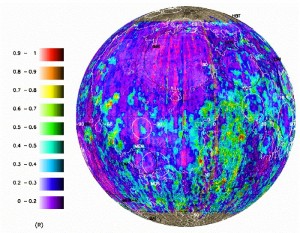The Strange Story of Lunar Magnetism
We’ve known since the beginning of the space age that the Moon has no global magnetic field.

We’ve known since the beginning of the space age that the Moon has no global magnetic field. Before we returned samples from the Moon, this was thought to be well understood – compared to Earth, the Moon is a small body (1% the mass) and it rotates very slowly (almost 30 times slower). The large magnetic field of Earth is generated in its very large, rapidly rotating, molten nickel-iron core. This process, called a core dynamo, is thought to be the principal explanation for global magnetic fields in planets throughout the Solar System. Thus, it’s not surprising that the Moon has no global field; for surface navigation, you can forget about packing a compass.
Rocks formed from cooling lava retain a memory of the strength and orientation of any magnetic field existing during their solidification. The magnetic domains in minerals align themselves with the direction of the prevailing magnetic field. As the rock cools below a critical point (the Curie point), the magnetic field is recorded as something called thermal remnant magnetism, which can be measured in the laboratory. Determination of remnant magnetism in Earth rocks has documented the existence of plate tectonics (continental drift), contributed to the unraveling of complex geological histories, and enabled the solution of many problems in terrestrial geology.
So it was quite the surprise to find that although there is no magnetic field around the Moon now, apparently there was one over 3 billion years ago. The Apollo samples were studied by every known technique, so measuring their remnant magnetism was one of many tests to which each sample was subjected. To everyone’s amazement, some of the lunar rocks were quite intensely magnetized – they cooled in the presence of a strong, steady oriented field. At first we thought this result simply must be wrong; perhaps the rock acquired it’s magnetism by traveling back from the Moon, through the strong magnetic fields that surround the Earth and give rise to its radiation belts and polar aurora. We even took one lunar sample back to the Moon, to be sure that its magnetism was not induced by the transport to Earth.
In conjunction with these sample results, some very strong local magnetic fields were recorded in place on the Moon’s surface by instruments carried by the Apollo astronauts and measured from orbit by robotic missions. John Young, Commander of the Apollo 16 mission, measured one of the strongest magnetic fields near his Descartes landing site, about one-hundredth the strength of Earth’s global field. It wasn’t until the flight of Lunar Prospector more than 26 years later that we found that his Descartes landing site is one of the strongest magnetic anomalies on the Moon. These magnetic anomalies have no clear or obvious distribution on the Moon, except many of them are associated with unusual bright swirls that appear to drape themselves over the landscape of the Moon.
Recently, a team from MIT has found remnant magnetism in a very old (almost 4.3 billion years) lunar rock. This rock is not a surface sample, created by impact and its associated shock, but rather, a deep-seated igneous rock, formed by the slow cooling of a magma at many kilometers depth within the Moon. The presence of a magnetic field in such a rock argues for 1) a stable, constant field, not likely to be achieved by impact; and 2) this field was in place early in lunar history. Both observations support the idea of a lunar core dynamo, one that somehow started early (sometime in the first few hundred million years of the Moon’s existence), operated for awhile, and then quit (around 3.5 billion years ago.) Is it really plausible for a body as small as the Moon to have had a molten core, generating a global field?
To say that this is scientifically troubling is an understatement. Scientists typically don’t like these “Just So” stories because they are simply contrivances that fit the presently known facts, and have little or no predictive power. A useful hypothesis not only explains the phenomena in question, it also has specific implications or predictions that can be explored and tested. If subsequent work shows the idea to be a false one, it is discarded. In fact, we need some mechanism to discard useless hypotheses, lest we be drowned in worthless trivia.
We appear to have a non-magnetic Moon, made up (at least in part) of magnetized rocks. In theory, there is no reason why a magnetic field should start, then abruptly stop operating. On Earth, reconstructing the magnetic story requires hundreds of carefully selected, oriented bedrock samples, something which we totally lack for the Moon. Resolving the paradox of the origin of lunar magnetism will be a high priority of lunar return.
/https://tf-cmsv2-smithsonianmag-media.s3.amazonaws.com/accounts/headshot/blog_headshot_spudis-300x300.jpg)
/https://tf-cmsv2-smithsonianmag-media.s3.amazonaws.com/accounts/headshot/blog_headshot_spudis-300x300.jpg)